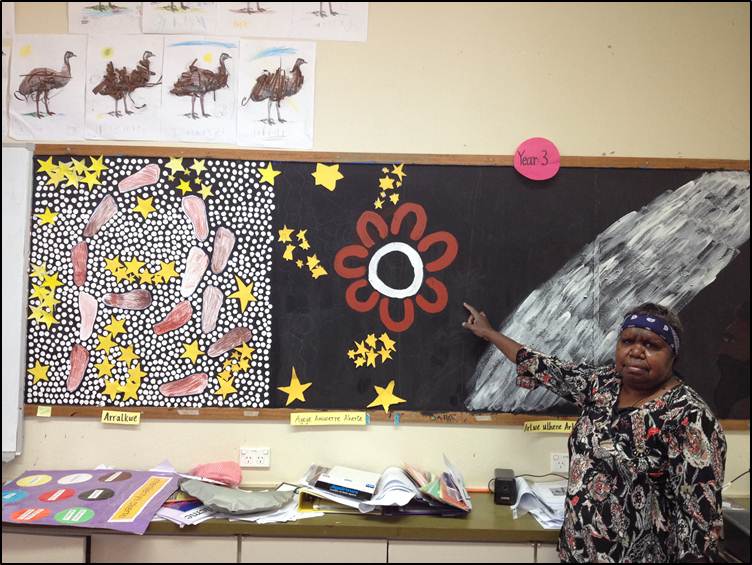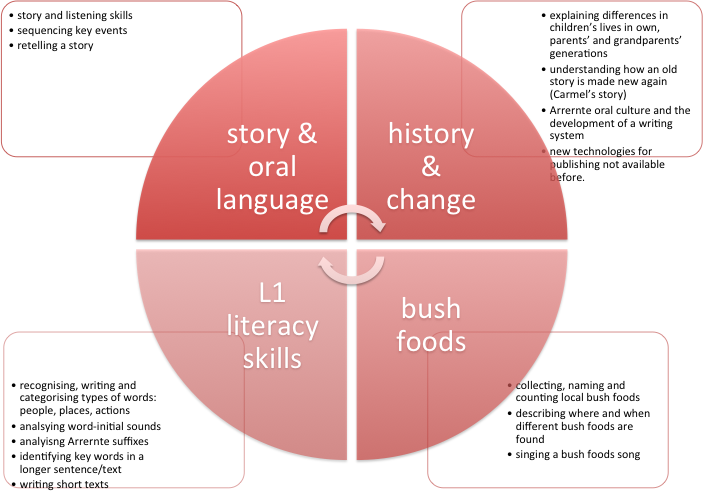
Download this T&L  sequence as a PDF here.
sequence as a PDF here.
Teaching & learning sequence, by Carmel Ryan & Susan Poetsch
| Key learning area | Northern Territory Curriculum Framework, Indigenous languages and cultures (NTCF ILC), language maintenance section.
Content outcomes:
Language outcomes:
Elements of language strands:
The class has a range of learner abilities, mostly within band 1 of the framework. |
| Students’ background, and unit rationale | This unit of work is written for Arrernte children with lived experience of their language and culture. They are still in the early stages of acquiring L1 literacy though. They have some knowledge of local bush foods but parents want them to learn more because these days food is most often bought in supermarkets. Families also want them to learn about changes in their community life because children’s free time is spent in very different ways compared with their parents and grandparents’ generations. |
| Teacher | Carmel Ryan |
| Year | Year 2, term 2 |
| Length of unit | 5 weeks, 2 x 45-minute lesson per week |
| Unit topic | This unit is based on the story:
Arlte pwetye-werne unthe-tyeke-arle alhe-ke akerte (A day some kids went for a walk) |
| Unit outcomes | By the end of this unit, students will be able to know/understand:
|
| Links to Australian Curriculum | Humanities and Social Sciences (History and Geography Year 2):
Visual Arts F-2
|
| Australian Curriculum
General Capabilities |
Literacy Numeracy ICT competence
Critical and creative thinking Ethical behaviour Personal and social competence Intercultural understanding |
Teaching & learning sequence overview
Arlte pwetye-werne unthe-tyeke-arle alhe-ke akerte
| Learning intentions
(NTCF ILC outcomes) |
Planned teaching & learning activities, and resources & materials | Assessment for and of learning |
| Communication R/V 1.1 read/view with understanding texts with familiar symbols and a range of written texts with familiar topics and vocabulary, illustrations and predictable text structures | Teacher-led shared and guided reading of the story text, using the PowerPoint version.
Students identify parts of the text, e.g. title, author, year, beginning and end of the story, Arrernte sections compared with English translation. Students identify any words in the text they already know, and note that some words have hyphens for suffixes. |
Teacher observes students’ ability to recognise and identify key features of text, and to predict story events before turning each page.
Teacher selects individual students to point to words as the class reads each page/slide. |
| Communication L/S 1.1 listen and speak formally and informally in learning contexts | Role play: teacher reads/tells the story, as students listen and act it out, e.g. going for a walk, swimming in a waterhole, climbing high trees, collecting bush foods, sharing food with younger siblings.
|
Teacher and Assistant Teacher observe students’ abilities to listen and respond to the events she reads/tells. |
| Communication L/S 1.1 listen and speak formally and informally in learning contexts | Using a set of small laminated cards of each picture in the story, students:
|
Teacher and Assistant Teacher check each student’s/pair’s sequencing and telling. |
| Language Structures and Features R/V 1.2 interpret some organisational features and punctuation in written texts; link most sounds with letters/symbols | When re-reading the story together as a class students locate 5 types of Arrernte words and phrases on the pages of the story: characters, things, places, actions, time.
|
Teacher and Assistant Teacher observation of students’ reading skills and their responses during the whole class activity and the card game. |
| Language Structures and Features R/V 1.3 recognise some ways in which sentences are structured
Language Structures and Features W 1.2 write most letters and symbols and some words correctly; follow the conventions of writing
Learning-how-to-learn Strategies W 1.3 use some strategies to plan and compose their own writing. |
Language and culture integrated with Australian Curriculum, Visual Arts F-2. Use the art room in the school to make a mural to display in the Arrernte classroom depicting the story events. Students later add Arrernte labels to the mural, using different colours for the 5 different types of words and phrases in the text of the story, e.g.:
|
Teacher and Assistant Teacher work with individual students and use a checklist to record their ability to locate key words in the story text, and categorise them according to the 5 word types. |
| Language Structures and Features R/V 1.3 recognise some ways in which sentences are structured | When re-reading the story together as a class:
|
Teacher and Assistant Teacher observation of students’ responses during class activities. |
| Learning-how-to-learn Strategies R/V 1.4 demonstrate some developing reading strategies to predict and confirm meaning in written and visual texts. | Each student is allocated some computer time to listen to the story independently with headphones, to practise reading along with the recording in PowerPoint. | When students have had a chance to independently listen and follow the story, Teacher and Assistant Teacher listen to each one read the text and make a running record. |
| Communication L/S 1.1 listen and speak formally and informally in learning contexts | The teacher focuses the students’ attention on PowerPoint slide 6, about looking for bush foods. Students use their knowledge of initial letters and sounds to find 2 key words and phrases in the text:
The class brainstorms bush foods they know and like, and any information they already know about those foods. From the brainstorm, create a class word bank of these (which students can refer to when completing the writing tasks coming up). |
Teacher and Assistant Teacher observe and guide students’ participation in and contributions to class discussion. |
| Learning-how-to-learn
Strategies L/S 1.3 demonstrate understanding of how listening and speaking are used for learning. |
Students participate in a short class excursion close to the school, to find some nearby bush foods. The teacher might also bring to class other examples of bush foods to show and taste. | Teacher and Assistant Teacher observes how students pay attention, ask and answer questions about bush foods. |
| Communication L/S 1.1 listen and speak formally and informally in learning contexts
Learning-how-to-learn Strategies L/S 1.3 demonstrate understanding of how listening and speaking are used for learning. |
Students complete worksheets and/or interactive whiteboard activities about the bush foods discussed and tasted, e.g.:
|
Teacher and Assistant Teacher collect and check each child’s worksheets and add them to individual portfolios. |
| Communication L/S 1.1 listen and speak formally and informally in learning contexts
Communication R/V 1.1 read/view with understanding texts with familiar symbols and a range of written texts with familiar topics and vocabulary, illustrations and predictable text structures |
Students learn the bush foods song, which has 4 verses about:
Song lyrics are projected on the board for students to become familiar with and follow. |
Teacher and Assistant Teacher observe students’ ability to read and follow lyrics, as they become familiar with the song. |
| Communication W 1.1 write different types of short texts containing more than one idea
Language Structures and Features W 1.2 write most letters and symbols and some words correctly; follow the conventions of writing |
Students write a new verse for the bush foods song, based on knowledge they gained from the class excursion and bush food tasting.
They use the same sentence structure in the song, but change the:
In pairs, students write a new song verse on a poster to display on the wall, or type it onto a PowerPoint slide to share with the class. Class learns and sings the newly-written verses of the song. |
Teacher and Assistant Teacher assist student pairs to draft and write/type their verses; and check the students’ writing for accurate content and spelling. |
| Communication L/S 1.1 listen and speak formally and informally in learning contexts
Learning-how-to-learn Strategies L/S 1.3 demonstrate understanding of how listening and speaking are used for learning. |
Language and culture integrated with Australian Curriculum, History and Geography (part 1):
Carmel shows the students the original book she wrote and talks about when she wrote it, how she was learning to write Arrernte at that time, how young her own children were at that time, and that there were no computers for her to use then. Students compare the old printed book with the new PowerPoint version. Class discusses what is different about the two of them, e.g.:
|
Teacher and Assistant Teacher observe and guide students’ participation in and contributions to class discussion. |
| Communication L/S 1.1 listen and speak formally and informally in learning contexts
Learning-how-to-learn Strategies L/S 1.3 demonstrate understanding of how listening and speaking are used for learning. |
Language and culture integrated with Australian Curriculum, History and Geography (part 2):
|
Teacher and Assistant Teacher observe and guide students’ participation in and contributions to class discussion. |
| Language Structures and Features L/S 1.2 create texts with linked ideas, accurate grammar, a developing vocabulary | Students draw a small picture about something they learned from the guest speaker’s talk and the class discussion. Their pictures are then displayed on a class chart about children’s lives with two columns: then and now.
In summary class discussion about the class chart, each child explains what their picture tells about children’s lives in their community then and now, in their grandparents’ compared with their own generation. |
Teacher and Assistant Teacher observe students’ skills in using Arrernte (e.g. verb suffixes) to express and compare past and present. |
| Learning-how- to-learn Strategies W 1.3 use some strategies to plan and compose their own writing. | Students complete a writing activity sheet on which they add their own ideas into a sentence frame in Arrernte. They compare/contrast children’s lives then and now, e.g.:
When my grandmother was a little girl children used to … … … … but today children … … … … Children practise reading their own and each other’s sentences. |
Teacher and Assistant Teacher work with individual students to draft and edit their text, and listen to each child reading the sentences.
Completed sentences are added to the students’ portfolios. |
Here’s is Carmel’s narrated Powerpoint presentation converted to video (original slides here)

